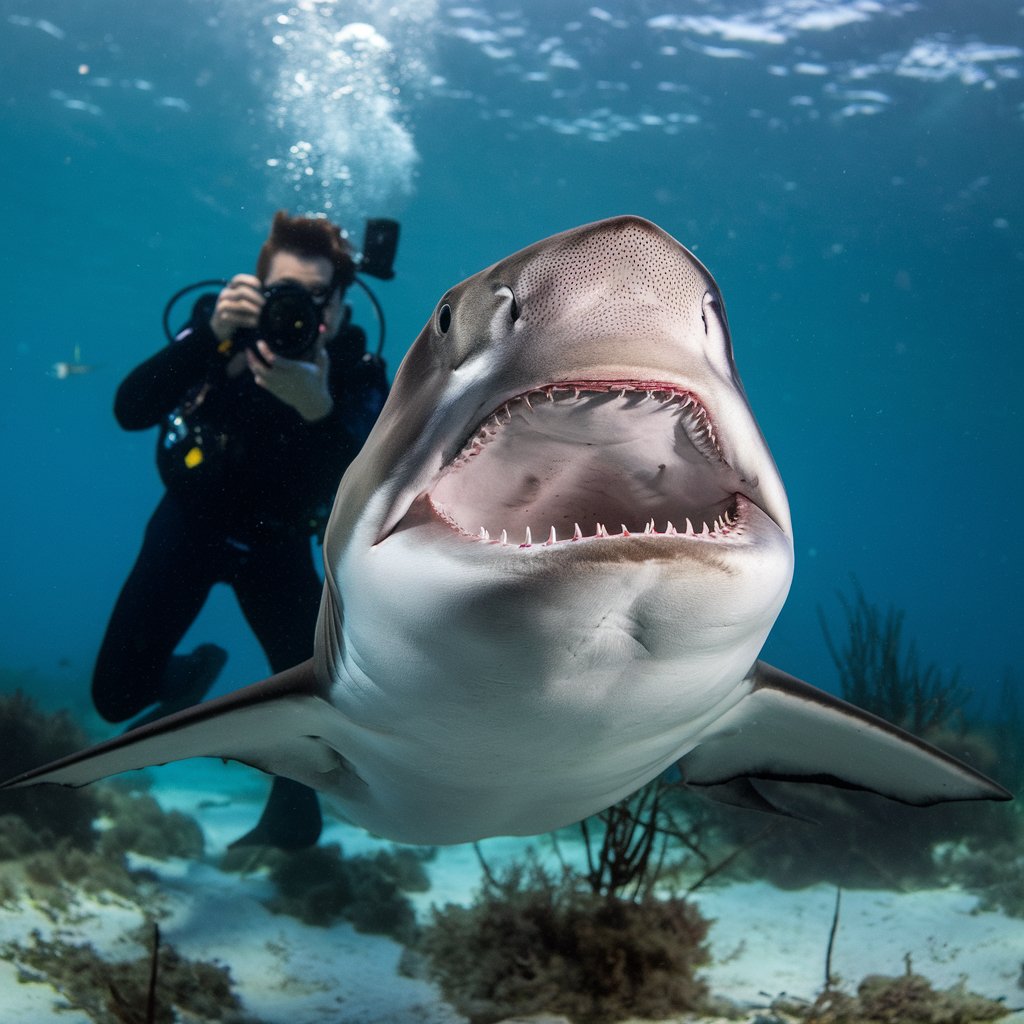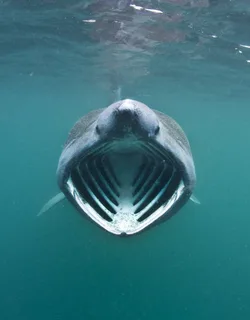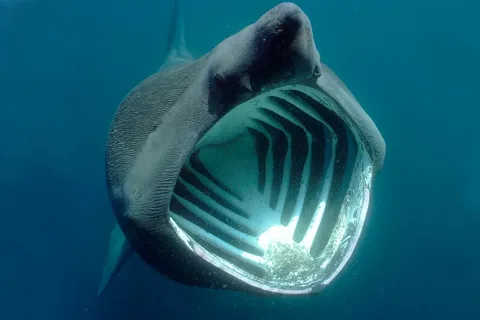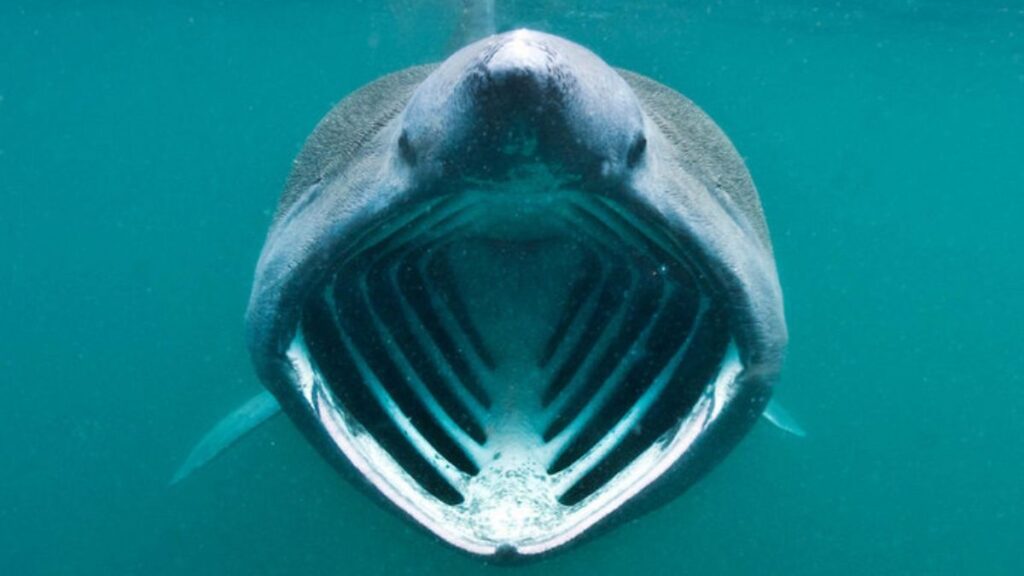When most people think of sharks, the image of a terrifying predator, like the great white shark, often comes to mind. These animals, known for their hunting prowess and aggressive behavior, have become notorious for their association with attacks on humans. However, there is one shark species that stands in stark contrast to this image: the basking shark. So, do basking sharks attack humans?
These gentle giants, while impressive in size, are not the fearsome predators many believe them to be. The truth is, basking sharks are far from dangerous. Instead, they are essential to the health of marine ecosystems, serving as vital players in regulating plankton populations and maintaining oceanic biodiversity.
Here’s a table summarizing the key facts and figures about basking sharks from the article:
| Fact/Attribute | Details |
|---|---|
| Scientific Name | Cetorhinus maximus |
| Size | 20-26 feet (with some individuals over 30 feet) |
| Weight | Up to 11,000 pounds |
| Mouth Width | Up to 3 feet wide |
| Diet | Plankton, small fish, microscopic organisms |
| Feeding Method | Filter feeder (gathers plankton as it swims through water) |
| Habitat | Temperate waters, including the UK, Ireland, and US coastlines |
| Typical Swimming Speed | 1-3 miles per hour |
| Largest Recorded Basking Shark | Over 30 feet long |
| Bycatch Issues | Threats from bycatch in fishing, fin trade, and pollution |
| Conservation Status | Vulnerable due to habitat degradation and human activities |
| Human Interaction | Peaceful, no attacks on humans; observed during snorkeling, diving, and kayaking |
| Role in Ecosystem | Regulates plankton populations; indicator species for marine health |
What Are Basking Sharks?
The basking shark (Cetorhinus maximus) is the second-largest living shark species in the world, surpassed only by the whale shark. Despite their immense size, basking sharks are entirely non-aggressive and are often considered gentle giants of the ocean. These sharks are known for their slow, filter-feeding habits and have been found in temperate waters around the world.
Physical Characteristics of Basking Sharks
To better understand why basking sharks do not pose a threat to humans, it’s important to first explore their physical characteristics:
- Size: Basking sharks typically grow between 20-26 feet, although some individuals have been recorded to reach lengths of over 30 feet.
- Weight: Adult basking sharks can weigh more than 11,000 pounds. Despite their enormous size, they are not built for active predation.
- Mouth: One of the most distinguishing features of basking sharks is their gaping mouth, which can open up to 3 feet wide. This large mouth helps them capture plankton and small fish as they swim through the water.
- Skin: Basking sharks have grayish-brown, mottled skin, which provides them with natural camouflage in the ocean, making them less visible to predators and prey alike.
Unlike other sharks that rely on sharp teeth and agility to hunt, basking sharks are filter feeders, meaning they passively gather food as they move through the water. Their primary diet consists of plankton, which includes tiny organisms like krill and microscopic marine creatures.

Do Basking Sharks Attack Humans?
The main question remains: do basking sharks attack humans? While it’s true that sharks, in general, are often portrayed as dangerous to humans, basking sharks are not one of those species. They are non-aggressive, and there is no evidence to suggest that basking sharks have ever attacked or posed a significant risk to humans.
Why Basking Sharks Are Not a Threat:
- Dietary Habits: Basking sharks are filter feeders, meaning they consume plankton and small marine organisms, not larger animals or humans. They rely on the abundance of plankton in the water to sustain them. As a result, they have no interest in attacking larger creatures or humans, as they are not part of their food chain.
- Non-predatory Nature: Unlike great white sharks or bull sharks, basking sharks do not hunt for prey. Instead, they cruise through the water, filtering plankton with their mouths wide open. Their feeding method is passive, not aggressive.
- Gentle Swimming Patterns: Basking sharks move at a slow pace, typically around 1-3 miles per hour. They glide through the water rather than engage in sudden bursts of speed or aggressive chasing. This makes them far less likely to pose any danger to humans.
Understanding Basking Shark Behavior
To understand why basking sharks don’t attack humans, we must look closely at their behavior in the wild. Unlike the fast-swimming and aggressive nature of many shark species, basking sharks are calm, slow-moving creatures that exhibit non-aggressive behavior.
Behavior of Basking Sharks:
- Slow Movement: Basking sharks swim at a relaxed pace, often near the water’s surface. They move deliberately, using their large, gaping mouths to filter-feed on plankton. This slow movement is characteristic of many filter-feeding sharks and is one of the reasons they are often perceived as more benign.
- Feeding Method: The gaping mouth of a basking shark is used to filter plankton from the water. As they swim, water flows into their mouths, passing through gill rakers that capture plankton and small fish. This feeding method requires a continuous motion, and basking sharks do not stop to attack or prey on other animals.
- No Hunting Instincts: Basking sharks do not exhibit the typical hunting or predatory behavior that other sharks do. Unlike great whites, which actively chase down and hunt seals or other mammals, basking sharks are focused solely on their feeding. They have no interest in larger prey.
The Role of Basking Sharks in the Marine Ecosystem
Basking sharks play a critical role in the marine ecosystem. As filter feeders, they help maintain balance by consuming plankton, which can otherwise overwhelm marine systems if left unchecked. Their role as indicator species reflects the health of the ecosystem, as the presence of basking sharks can indicate a thriving marine environment with abundant plankton.
Importance to the Ecosystem:
- Regulating Plankton Populations: By feeding on plankton, basking sharks help prevent these microscopic organisms from reaching unsustainable levels. This is vital in ensuring that plankton does not deplete the nutrient base for other marine life.
- Biodiversity and Food Web: Basking sharks contribute to the balance of the food web by keeping plankton populations in check, supporting the overall marine biodiversity. Without these sharks, plankton could proliferate unchecked, which might disrupt the entire marine food chain.

Image Source:Livescience.com
Documented Human Interactions with Basking Sharks
While basking sharks are known for their non-aggressive behavior, they do have documented interactions with humans, particularly in areas where they are commonly seen.
Real-Life Examples of Human Interaction:
- Snorkeling and Diving: In regions like the UK and Ireland, snorkelers and divers often have the opportunity to encounter basking sharks. These interactions are typically peaceful, with basking sharks showing no signs of aggression. The sharks are generally indifferent to humans, more focused on their feeding than engaging with people.
- Kayaking: In some cases, kayakers have reported encountering basking sharks that have swum alongside them without any incident. These peaceful interactions are a testament to the non-aggressive nature of basking sharks, which are not interested in threatening or attacking humans.
- Tourism: Wildlife tourism has become a significant industry in regions where basking sharks are found. Tourists flock to places like the US coastlines and the coasts of the UK to experience these creatures up close. The sharks’ calm demeanor allows humans to observe them without any risk, which makes them a popular attraction in eco-tourism ventures.
The Importance of Respectful Interaction
While basking sharks are peaceful, it’s crucial to approach them with respect. Like all wildlife, they should not be touched or provoked. Observers should maintain a safe distance and avoid any sudden movements. This ensures both the safety of humans and the sharks.
Why Basking Sharks Don’t Attack Humans
There are several factors contributing to the fact that basking sharks do not attack humans. The primary reasons lie in their evolutionary adaptations and natural behaviors.
Dietary Preferences:
Basking sharks are strictly plankton feeders. Their diet consists mostly of small fish, microscopic organisms, and plankton. Humans, being far too large to fit within this dietary preference, simply aren’t on the menu. Their gaping mouths are designed to collect small particles from the water, not to bite or tear larger prey.
Behavioral Patterns:
Basking sharks’ passive nature is a result of their evolutionary adaptations. They are not built to chase prey or engage in predation. Instead, they filter water for plankton, often staying near the surface to capture this food source. Their slow movements and non-aggressive behavior ensure that they are not a threat to humans.
Anatomical Features:
Basking sharks do not possess the type of teeth that would be useful for attacking larger animals. Unlike the sharp, pointed teeth of great white sharks, basking sharks have small, tooth-like structures that help them capture plankton. This makes it physically impossible for them to harm a human in the way that other sharks might.

Image Source:rutube.ru
Common Misconceptions and Myths
Many myths surrounding basking sharks have led to misconceptions about their behavior. Here are some of the most common:
Myth 1: Basking Sharks Are Aggressive
Due to their large size and gaping mouths, basking sharks are often mistaken for aggressive predators. However, their feeding behavior and non-aggressive nature make them harmless to humans.
Myth 2: Basking Sharks Will Attack If Provoked
Some people believe that basking sharks may become aggressive if provoked. However, basking sharks are peaceful creatures and do not exhibit aggressive behavior when approached by humans.
Myth 3: Basking Sharks Pose a Danger to Swimmers
Despite their large size, basking sharks are not a threat to swimmers, kayakers, or divers. Their focus on feeding and lack of predatory behavior make them completely safe to observe in the wild.
Safety Tips for Observing Basking Sharks
While basking sharks are harmless, there are still some safety guidelines to follow when observing them in the wild. Here are some essential tips:
Safety Guidelines for Shark Observation:
- Keep a safe distance: Maintain at least 10-15 feet between yourself and the shark to avoid disturbing it.
- Do not touch: Although basking sharks are gentle, it is important not to touch or attempt to interact physically with them.
- Avoid sudden movements: Sharks, even non-aggressive ones, can be startled by sudden or erratic movements. Approach them calmly and quietly.
By following these guidelines, you ensure that your encounter with a basking shark is both safe and respectful.
The Role of Basking Sharks in the Marine Ecosystem
Basking sharks play a critical role in maintaining the balance of the marine ecosystem. As filter feeders, they help regulate plankton populations, which ensures the overall health of the ocean.
Ecosystem Benefits:
- Indicator species: Basking sharks are often used as indicator species for marine health. Their presence in a particular area signifies a healthy, nutrient-rich ecosystem.
- Plankton regulation: Basking sharks feed on plankton, which helps prevent overpopulation and ensures a balanced marine environment.
Without basking sharks, the delicate ecosystem balance could be disrupted, affecting the entire food chain. Their role in biodiversity is irreplaceable, making them essential for maintaining marine life health.
Basking Sharks in Popular Culture
While basking sharks rarely feature prominently in popular media, they are occasionally depicted in documentaries and nature specials, where they are shown as calm, slow-moving creatures. However, mainstream media often perpetuates the image of sharks as bloodthirsty predators, which distorts public perception.
Media Portrayal:
- Nature documentaries often portray basking sharks in their natural habitat, showcasing their peaceful nature and slow-moving habits.
- Misconceptions: Despite their appearance in these documentaries, media stereotypes still associate all sharks with aggression, which adds to the fear and misunderstanding surrounding basking sharks.

Image Source:dzen.ru
FAQs
Has the basking shark ever attacked humans?
Basking sharks are generally gentle creatures, but in a rare 1937 incident, one capsized a boat, resulting in the drowning of three passengers.
Are basking sharks aggressive?
Basking sharks are passive and not a danger to humans, though their size and rough skin require caution during encounters.
Has a basking shark ever eaten a human?
Basking sharks do not consume meat and have no interest in eating humans, as they are filter feeders that primarily eat plankton.
What should you do if you encounter a basking shark?
If you spot a basking shark, reduce your speed, avoid abrupt course changes, and carefully keep out of its path.
Can you touch a basking shark?
It is not recommended to touch basking sharks; maintaining a safe distance is essential for both your safety and the shark’s well-being.
Can you swim with basking sharks?
Swimming with basking sharks is possible in certain protected areas, offering a rare chance to experience these gentle giants in their natural habitat.
Are whale sharks friendly?
Whale sharks are docile and friendly, showing curiosity and playfulness, making them a popular choice for snorkeling with no real threat to humans.
Has anyone ever caught a basking shark?
A basking shark was accidentally caught by a trawler in 2015 near Portland, Australia, marking the first in the region in decades.
What is the lifespan of a basking shark?
Basking sharks can live up to 50 years, reaching lengths of 7-9 meters and migrating extensively during their lives.
What eats a basking shark?
Basking sharks have few predators, though they might fall prey to large sharks or orcas in rare instances.
Are basking sharks peaceful?
Despite their size, basking sharks are peaceful creatures, feeding on plankton and posing no harm to humans.
Can a human fit inside a basking shark?
While a human could fit inside a basking shark’s large mouth, it would show no interest in eating due to its filter-feeding diet.
What is bigger, a whale shark or a basking shark?
The whale shark holds the title of the largest shark, reaching lengths of up to 18.8 meters, while the basking shark grows to about 12.3 meters.
Do basking sharks eat meat?
Basking sharks are filter feeders, consuming plankton and small organisms rather than meat.
Is a basking shark gentle?
Yes, basking sharks are known for their gentle nature, cruising slowly through the water while filtering food with their large mouths.

Image Source:Livescience.com
Final Verdict: Are Basking Sharks a Threat to Humans?
The final verdict is clear: basking sharks are not a threat to humans. These gentle giants are peaceful, slow-moving filter feeders that have no interest in attacking humans. While they may appear intimidating due to their size and large mouths, they are harmless creatures focused on feeding on plankton, small fish, and microscopic organisms.
By understanding basking sharks’ role in the marine ecosystem, their non-aggressive nature, and their behavior, we can dispel myths and educate the public about these magnificent creatures. Through increased awareness and conservation efforts, we can ensure that basking sharks continue to thrive in our oceans for generations to come.
Read more knowledgeable blogs on Flowy Magazine

James Clair is a passionate writer and researcher with a deep fascination for animal behavior and its intricate connection to human life. With a background in [relevant field of study, e.g., zoology, psychology, ethology], James has spent years studying the natural world, focusing on how animals’ actions and instincts impact human emotions, behavior, and society.
His expertise in [specific topics or regions of focus, e.g., canine psychology, animal communication, wildlife conservation] has led to numerous published works and collaborations with renowned researchers and institutions. Through his work at Flawy Magazine, James aims to bridge the gap between scientific research and public understanding, offering insightful, accessible articles that explore the complex relationship between humans and animals.
When he’s not writing, James enjoys [personal hobbies or interests, e.g., hiking in nature, volunteering at animal shelters, photography] and is an advocate for [cause or charity related to animals or conservation]. His mission is to inspire readers to see animals not just as companions or creatures of the wild, but as beings whose behavior holds valuable lessons for us all.









